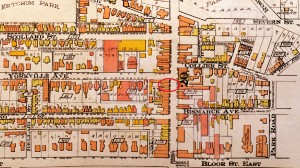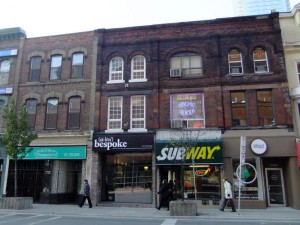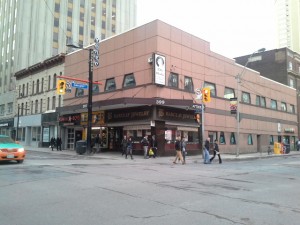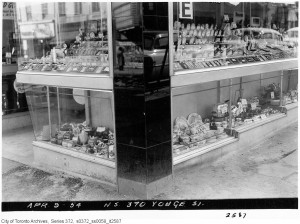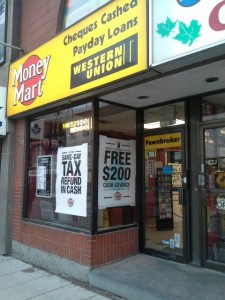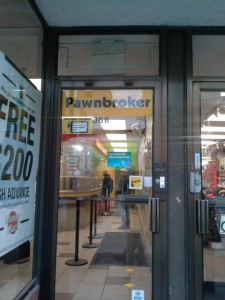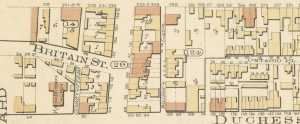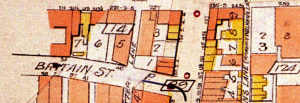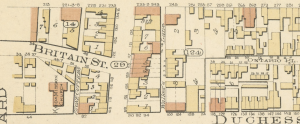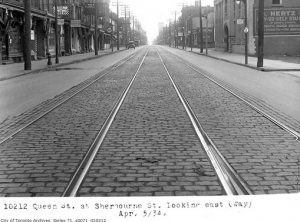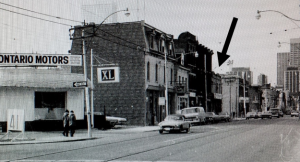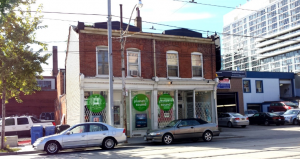The History of Chinatown Restaurants
The History of Chinese Restaurants viagra 75 mg Source: “Chinese History in Toronto” 1toronto.ca. Toronto Archives. N.d. Web. 7 Feb 2015. sildenafil 50 mg para eyaculacion precoz The Beginning Due to the increasing number of Chinese immigrants coming to Toronto, Chinatown became a popular residential and commercial centre for many businesses including restaurants, laundries, and […]
The Chinese in Early 20th Century Toronto: 846 Yonge Street
846 Yonge Street has a multifaceted and rich history, hosting operations as a laundry facility, auto mechanic garage, a Canadian Tire in 1955 and most recently as the hair-styling Salon Bespoke, the establishment that occupies the building today. Valerie Mah’s invaluable manuscript The Bachelor Society confirms the scant details known about operations at the turn of the previous century. As of 1899 the property was merely designated as a nondescript Chinese Laundry, but circa 1900 was listed as being rented to a specific Chinese entrepreneur. The registered owner of the building, James Weir, lived just down the street at 783 Yonge Street. It is interesting to note that that at the young age of 23, one Lee Kam You is documented as the presiding business owner at that time. There were a total of 4 residents listed as living at the premise, but only Lee Kam You’s name and details were to be found in historical accounts of the time. As of 2014 the whole adjoining stretch of commercial properties, ranging from 838-848 Yonge Street, was purchased by Bazis International for development of the newly conceived 1 Yorkville Condo Project. Previously valued at $1,474,000 in the 2014 Toronto Tax rolls, the proposed plans thankfully include a conservation strategy to preserve the heritage commercial building properties gracing the front area of Yonge Street, dating back farther than even the dawn of the last century.
Works Cited
Assessment Rolls: Ward 3 Division 3. 1899-1900. Toronto Archives. Microform.
Goads Fire Insurance Plan (1913, plate 1a). Web. Obtained 05/02/2014 from http://www1.toronto.ca/wps/portal/contentonly?vgnextoid=04ab757ae6b31410VgnVCM10000071d60f89RCRD&vgnextfmt=default#central
Mah, Valerie. The Bachelor Society: A Look at Toronto’s Early Chinese Community from 1878 – 1924 (unpublished, 1978).
Staff report for action – Preliminary Report – 836-850 Yonge St/1-9A Yorkville Ave. Web. Obtained 05/11/2014 from http://www.toronto.ca/legdocs/mmis/2014/te/bgrd/backgroundfile-64732.pdf
Toronto City Directory. 1899-1900. Toronto Archives. Microform.
The Chinese in Early 20th Century Toronto: 399 ½ Yonge Street (East side)
During 1899, a man named Sing Law operated a laundry store at 399 ½ Yonge Street. The laundry operation changed owners in 1900 to Park John and in 1901 to Lee John. The landlord in 1899 named John Phipps died in 1900 leaving his estate to his wife Julia Phipps.
The information found in the Assessment rolls corresponds to that found in the Toronto City Directory from 1899 – 1901. Every other year the owner of the laundry store underwent a change.
Yonge Street has been the most historical street name in Toronto and has not undergone a street name change for the last century. According to Goads Fire Insurance Plans, 399 ½ Yonge Street was located on “Plan: 22A ; PT: Lots 37” intersecting on Yonge Street and Gerrard Street. After checking with the Toronto Archives computer directory I found out that, 399 ½ Yonge Street back in 1899 has changed to 399 Yonge Street today. The street number 399 ½ Yonge Street does not exist anymore.
Work Cited
Assessment Roll: Ward 3, Division 2 1899
Assessment Roll: Ward 3, Division 2 1900
Assessment Roll: Ward 3, Division 2 1901
Toronto: Might’s Directory Co. 1899. Microform. The Toronto city directory for 1899
Toronto: Might’s Directory Co. 1900. Microform. The Toronto city directory for 1900
Toronto: Might’s Directory Co. 1901. Microform. The Toronto city directory for 1901
Goads Fire Insurance Plans: Central Toronto 1899; Toronto Archives Website
The Chinese in Early 20th Century Toronto: 370 Yonge Street (West Side)
During 1899 a store called Ying Chong Tai Co. selling ‘Japanese Goods’ was located at 370 Yonge Street. According to the Assessment role in 1899, the resident at this occupation was selling “Fancy Goods”. The landlord, identified as Rufus Skinnerd, resided at Walton Street. Throughout 1900 and 1901, Ying Chong Tai Co. still existed but the landlord moved from his previous address to live at the apartment building above the store on 370 Yonge Street.
The Toronto City Directory from 1899 – 1901 reveals that above the Japanese Goods store, two people named Park Mark and Sing Mark resided here during 1899. The landlord occupied the building in 1901.
Yonge Street has been the most historical street name in Toronto and has not undergone a street name change for the last century. According to Goads Fire Insurance Plans, 370 Yonge Street was located on “Plan: D4 ; PT: Lots 2 & 3” intersecting on Yonge Street and Walton Street. After checking with the Toronto Archives computer directory, I found out that 370 Yonge Street back in 1899 has changed to 368 Yonge Street today. The street number 370 Yonge Street does not exist anymore.
Work Cited
Assessment Roll: Ward 3, Division 2 1899
Assessment Roll: Ward 3, Division 2 1900
Assessment Roll: Ward 3, Division 2 1901
Toronto: Might’s Directory Co. 1899. Microform. The Toronto city directory for 1899
Toronto: Might’s Directory Co. 1900. Microform. The Toronto city directory for 1900
Toronto: Might’s Directory Co. 1901. Microform. The Toronto city directory for 1901
Goads Fire Insurance Plans: Central Toronto 1899; Toronto Archives Website
The Chinese in Early 20th Century Toronto: 215 1/2 Queen Street East
A July 1900 letter to Rev. MacKay from Thomas Humphries, indicated that there was 95 Chinese owned establishments in Toronto. In this letter, Hong Lee was listed as the resident at 215 ½ Queen St. East. The assessment rolls list confirm that Lee lived at this address from 1898-1902. Lee first moved into 215 ½ Queen St. East when he was 34-years old before moving sometime in 1902, as he is no longer listed in the assessments from the year 1903 on wards.
It is difficult to imagine that the now vacant store below was once Hong Lee’s Laundromat. In fact, there is no longer a 215 ½ Queen St. East. Instead it is just 215 Queen St. East. During Lee’s time at the address the main intersection was Queen St. East and Sherbourne St. This has not changed, with the exception of the next street west being Jarvis St. instead of Fredrick St.
The Goads Fire Insurance Plans from 1899 does not list the house number 215 ½ on Queen St. East. However, it is listed later on in the 1924 Goads Fire Insurance Plan. The 1924 map indicates that the building was made out of brick. Furthermore, while the assessment role for year 1900 lists Lee as living alone, in the year 1902 it is noted that he lived there with another resident.
From the assessments it can also be noted that Lee was Christian and that his taxes went towards the Public School system. His landlord was Phillip Jameson and his property was 11 x 120 Square Feet.
Sources:
Ward 2 Division 1 1903 Assessment Roll
Ward 2 Division 1 1902 Assessment Roll
Ward 2 Division 1 B1901 Assessment Roll
Ward 2 Division 1B 1900 Assessment Roll
Ward 2 Division 1B 1899 Assessment Roll
City of Toronto Website: Goads Fire Insurance Plan(1899 and 1924)
Google Map 215 Queen Street East : https://www.google.com/maps/place/215+Queen+St+E/@43.6542929,-79.3702463,17z/data=!3m1!4b1!4m2!3m1!1s0x89d4cb376c73e579:0xb6fbcb2c54e1a129
The Chinese in Early 20th Century Toronto: 263 Queen Street East
Sam Wing lived at 263 Queen Street East when he was 32 years old. Based on the assessments he lived alone and was a Christian. His total taxable income was $1,645 and this income stayed the same for the two years that he lived at 263 Queen Street East.
For the 2 years that he lived on the property Sam Wing operated it as a Chinese Laundry mat. After Sam Wing left 263 Queen Street East, the property continued to operate as a Chinese Laundry, run by another Chinese owner, for many years.
While there were some vacancies between 1902 and throughout the 1960’s a City of Toronto heritage report notes that during the 1950s and 1960s the unit was continually operated as a Chinese Laundry.
The landlord for Sam Wing’s property was Christina Lauder, who owned a large portion of real estate on Queen Street East between Sherbourne St. and Ontario St. Currently, there is no longer a laundry mat at 263 Queen Street East. It is now a Planet of Sound store that sells headphones and speakers.
The 263 Queen Street East building was designed in 1875 by Christina Lauder and everything on the exterior remains the same as it was originally designed. The 263 Queen Street East commercial unit along with any other units designed by Christina Lauder are City of Toronto heritage properties.
Sources:
Assessment Roll: Ward 2 Division 1 1901
Assessment Roll: Ward 2 Division 1 1900
City of Toronto Archives: Goads Fire Insurance Plan (1899)
http://www.toronto.ca/archives/maps/goads-atlases/1903/g1890_1903_pl0029.jp2
City of Toronto Staff Report:
http://www.toronto.ca/legdocs/mmis/2013/pb/bgrd/backgroundfile-62855.pdf
The Chinese in Early 20th Century Toronto: 1120 1/2 Queen Street West
Works Cited
Assessment Roll: Ward 5, Division 1 1900.
Assessment Roll: Ward 5, Division 2 1900.
Mah, Valerie. The bachelor society: a look at Toronto’s early Chinese community from 1878-1924. MA Thesis. 1978. Print.
The Chinese in Early 20th Century Toronto: 465 College Street
or many years in the early 1900s.
Works Cited
Assessment Roll: Ward 5, Division 1 1900.
Assessment Roll: Ward 5, Division 2 1900.
Mah, Valerie. The bachelor society: a look at Toronto’s early Chinese community from 1878-1924. MA Thesis. 1978. Print.


